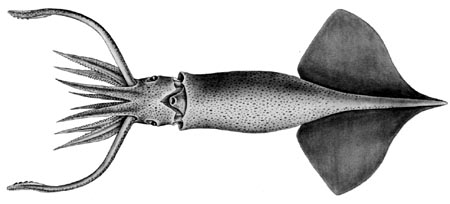Onychoteuthis borealijaponicus
Michael Vecchione, Richard E. Young, and Kotaro TsuchiyaIntroduction
Onychoteuthis borealijaponicus is the most abundant onychoteuthid in the temperate to boreal North Pacific. It is the largest member of the genus, reaching a ML of 350 mm. The large number of hooks on the tentacular clubs, the most of any member of the genus, allows easy identification.
Diagnosis
An Onychoteuthis ...
- with 24-27 hooks on tentacular club.
Characteristics
- Tentacular club
- Club with 24-27 hooks.
- Club without any marginal suckers in subadults.
- Several distal ventral-series hooks have spikes (arrow in bottom photograph points to most obvious spike).
 image info
image info
 image info
image infoFigure. Oral views of the tentacular club of O. borealijaponicus. Top - Full club, 81 mm ML, off southern California. Drawing from Young (1972). Bottom - Distal portion of preserved tentacular club, 175 mm ML, 45°N, 175°W. Photograph by R. Young.
- Photophores
- Visceral photophores slender: Posterior visceral photophore width ave. 61% of length (range 53-69%).
 image info
image info  image info
image infoFigure. Ventral views of visceral photophores: Top left - O. borealijaponicus, 81 mm ML, off southern California. Drawing from Young (1972). Bottom left - Onychoteuthis sp., off Florida, with larger, round photophores. Drawing from Young (1972). Right - O. borealijaponicus, 78 mm ML, preserved. Photograph by R. Young.
- Visceral photophores slender: Posterior visceral photophore width ave. 61% of length (range 53-69%).
Comments
Additional features of the description can be found here.Life History
O. borealijaponicus migrates into subarctic waters to feed during the summer and returns to subtropical waters for spawning in fall and winter; males mature at about 250 mm ML and females at 300-350 mm ML (Kubodera, et al., 1998).
Distribution
The type locality is the waters off Japan. This species occurs in the North Pacific from the Aleutian Islands to southern Japan and Baja California (Nesis, 1982/87).
References
Kubodera, T., U. Piakowski, T. Okutani and M. R. Clarke. 1998 Taxonomy and zoogeography of the family Onychoteuthidae. Smiths. Contr. to Zoology, No. 585: 277-291.
Nesis, K. N. 1982/87. Abridged key to the cephalopod mollusks of the world's ocean. 385+ii pp. Light and Food Industry Publishing House, Moscow. (In Russian.). Translated into English by B. S. Levitov, ed. by L. A. Burgess (1987), Cephalopods of the world. T. F. H. Publications, Neptune City, NJ, 351pp.
Young, R. E. 1972. The systematics and areal distribution of pelagic cephalopods from the seas off Southern California. Smithson. Contr. Zool., 97: 1-159.
Title Illustrations
| Scientific Name | Onychoteuthis borealijaponicus |
|---|---|
| Location | Off Southern California, USA |
| Reference | Young, R. E. 1972. The systematics and areal distribution of pelagic cephalopods from the seas off Southern California. Smithson. Contr. Zool., 97: 1-159. |
| Size | 50 mm ML |
| Copyright | © Richard E. Young |
About This Page
National Marine Fisheries Service
Systematics Laboratory
National Museum of Natural History
Washington, D. C. 20560
USA
Richard E. Young
Dept of Oceanography
University of Hawaii
Honolulu, Hawaii 96822
USA
Tokyo University of Fisheries, Konan, Minato, Tokyo
Page copyright © 2003 , Richard E. Young, and
- First online 23 June 2003
Citing this page:
Vecchione, Michael, Young, Richard E., and Tsuchiya, Kotaro. 2003. Onychoteuthis borealijaponicus . Version 23 June 2003 (under construction). http://tolweb.org/Onychoteuthis_borealijaponicus/19963/2003.06.23 in The Tree of Life Web Project, http://tolweb.org/








